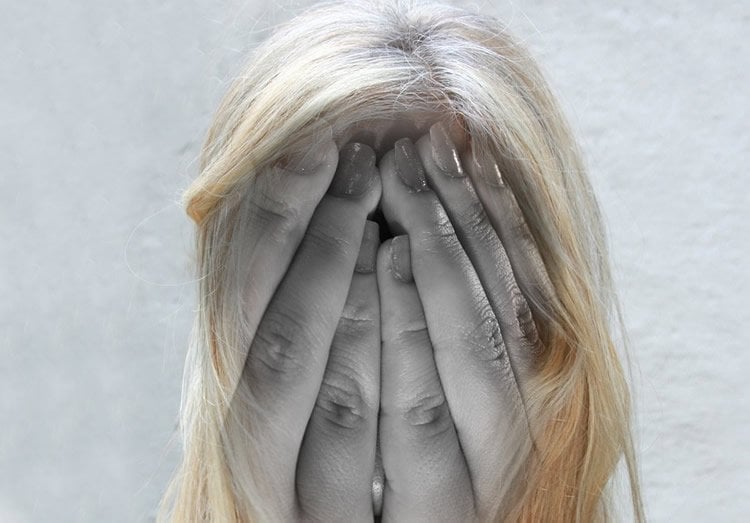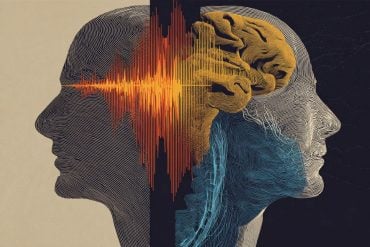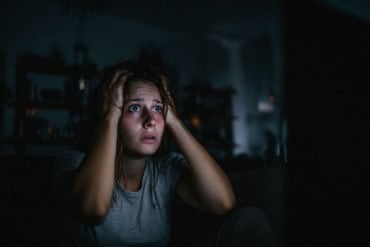Summary: According to researchers, lower levels of progesterone was associated with higher incidences of migraines in older teen girls, while in younger teens, the opposite was true.
Source: University of Cincinnati.
Changes in female hormones may trigger headaches in adolescent girls, but their effect may depend on age and their stage of pubertal development, according to a new study from researchers at University of Cincinnati College of Medicine and Cincinnati Children’s Hospital Medical Center.
The study, “Ovarian Hormones, Age and Pubertal Development and their Association with Days of Headache Onset in Girls with Migraine: An Observational Cohort Study” is currently available in the online edition of Cephalalgia, the scholarly journal of the International Headache Society. The study found that higher levels of the sex hormone progesterone were associated with fewer headaches in older teenagers, while lower levels resulted in more headache in that group. In younger girls, the opposite appears to be true.
“Ours is the first study to show that migraine headaches might also be influenced by female hormones in girls with migraine,” says Vincent Martin, MD, professor in the UC Division of General Internal Medicine and co-director of the Headache and Facial Pain Center at the UC Gardner Neuroscience Institute. “While low and declining estrogen levels are thought to precipitate migraine in adult women we found that progesterone to be the most important trigger factor in these young girls. However, this effect seemed to differ depending on the age of the girls and their pubertal development.”
Nationally, about 10 percent of school age children suffer from migraine, according to the Migraine Research Foundation (MRF). As adolescence approaches, the incidence of migraine increases rapidly in girls and by age 17 about 9 percent of boys and 23 percent of girls have experienced migraine, the MRF reports.
Past studies have shown that female hormones are an important contributor for migraine in adult women, explains Martin, also a UC Health physician. Two thirds of adult women will develop migraine attacks of that occur shortly before or during menstrual bleeding. These attacks have been called “menstrual migraine.” Low and declining levels of estrogen are thought to trigger attacks of menstrual migraine. Prior to this study the contribution of female hormones on migraine was unknown in girls and at what age this might occur, says Martin.
“There is a dramatic change in the way that female hormones affect migraine that occurs during puberty,” says Martin. “Prior to puberty progesterone has little effect on migraine, but after puberty high progesterone levels are associated with fewer headaches and low progesterone levels have more headache.”
Researchers as part of a 13-month study examined 34 girls experiencing migraine distributed across three age strata, ages 9 to 11, 12 to 15 and 16 to 17. Daily urine samples were collected and the occurrence and severity of headaches was recorded in diary for a 90-day period. The urine samples were evaluated for metabolites of the sex hormones estrogen and progesterone to determine if their presence was associated with days of headache onset or severity.
All participants were patients of Cincinnati Children’s Headache Center. The adolescents were offered a nominal stipend to encourage study compliance.
Higher levels of progesterone appeared to be associated with reduced frequency of headaches in older teens. In the 16 to 17 age group there was a 42 percent chance of having a headache when levels of progesterone were low in urine samples, while when levels of the hormone was higher the chance of headache dropped to 24 percent, says Martin.
In the 9 to 11 age group, there was 15 percent chance of suffering from migraine or headache when levels of progesterone were low, but a 20 percent chance of migraine or headache when high levels of progesterone were found in the urine, explains Martin.
“The shifting contribution of female hormones to migraine occurrence from pre-pubertal girls through puberty into adulthood suggests a very dynamic process,” says Andrew Hershey, MD, PhD, endowed chair and director of neurology at Cincinnati Children’s Hospital Medical Center. “As the brain is developing in these girls there may be differences in the brain receptors sensitivity and their roles in migraine occurrence. The role of these receptors appear to shift from progesterone to estrogen as these girls progress through puberty. As the brain matures it could respond differently to hormones than a non-maturated brain.”
Girls may first start entering puberty between age 9-10 years old, although their first period may not be until age 12 or later. As they progress through this pubertal development, there may be cyclic hormonal fluctuations and irregular menstrual periods, explains Hershey.
“We have previously demonstrated that a monthly headache pattern can begin during these early stages. As they age, their menstrual periods become more regular as do hormone fluctuations and by age 17, most girls are demonstrating adult hormone patterns,” says Hershey. “But just having fluctuations in hormones or regular menstrual periods isn’t enough to account for the differences in headache severity and onset displayed by younger girls compared to older teens.”

Martin says the research team was able to account for cyclic changes of hormones and that they were not found to be predictive of headache onset. “What I can say with the urine progesterone levels is that they were preventive in the older teens and that was more of an adult response; it is what you would expect to see in older women.”
“Our study suggests that female hormones play an important role in triggering headaches in young girls and that their response to hormones seems to change at the time of puberty,” says Martin. “Since migraine commonly begins during puberty in girls one might ask whether a change in response to hormones might represent the initiating factor for migraine in some girls- kind of like the “big bang” theory of migraine.”
Martin and Hershey teamed with Scott W. Powers, PhD, professor of pediatrics at UC and co-director of the Cincinnati Children’s Headache Center; Marielle Kabbouche, MD, professor of pediatrics at UC and director of the Acute and Inpatient Headache Program at Cincinnati Children’s; Hope O’Brien, MD, associate professor of pediatrics at UC and program director of Headache Medicine Education at Cincinnati Children’s; and Joanne Kacperski, MD, assistant professor of pediatrics at UC and director of the Post Headache Concussion Program at Cincinnati Children’s. Team members also included Cincinnati Children’s researchers, Janelle Allen, Susan LeCates, Polly Vaughan and Shannon White and Timothy Houle, PhD, Harvard University.
Martin is president of the National Headache Foundation. He is a speaker for Teva Pharmaceutical Industries, Allergan Plc., Avanir Pharmaceuticals and Depomed, Inc. Martin is also a consultant for NeuroScion, Avanir Pharmaceuticals, Depomed, Inc., Eli Lilly and Company, Amgen Inc., and Alder Biopharmaceuticals.
Hershey is a consultant for Allergan Plc., Amgen Inc., Curelator Headache, Depomed, Inc. and Eli Lilly and Company.
O’Brien is a speaker for Avanir Pharmaceuticals.
Funding: The study received financial support from the National Headache Foundation and the Driskill Foundation.
Source: Cedric Ricks – University of Cincinnati
Image Source: NeuroscienceNews.com image is in the public domain.
Original Research: Full open access research for “Ovarian hormones, age and pubertal development and their association with days of headache onset in girls with migraine: An observational cohort study” by Vincent T Martin, Janelle R Allen, Timothy T Houle, Scott W Powers, Marielle A Kabbouche, Hope L O’Brien, Joanne Kacperski, Susan L LeCates, Shannon White, Polly Vaughan, Karen Mandell, and Andrew D Hershey in Cephalalgia. Published online May 5 2017 doi:10.1177/0333102417706990
[cbtabs][cbtab title=”MLA”]University of Cincinnati “Female Hormones May Trigger Headaches in Girls Battling Migraine.” NeuroscienceNews. NeuroscienceNews, 9 May 2017.
<https://neurosciencenews.com/progesterone-migraine-6622/>.[/cbtab][cbtab title=”APA”]University of Cincinnati (2017, May 9). Female Hormones May Trigger Headaches in Girls Battling Migraine. NeuroscienceNew. Retrieved May 9, 2017 from https://neurosciencenews.com/progesterone-migraine-6622/[/cbtab][cbtab title=”Chicago”]University of Cincinnati “Female Hormones May Trigger Headaches in Girls Battling Migraine.” https://neurosciencenews.com/progesterone-migraine-6622/ (accessed May 9, 2017).[/cbtab][/cbtabs]
Abstract
Ovarian hormones, age and pubertal development and their association with days of headache onset in girls with migraine: An observational cohort study
Background
Fifty-three percent of adolescent girls report headaches at the onset of menses, suggesting fluctuations of ovarian hormones trigger migraine during puberty.
Aims
To determine if urinary metabolites of estrogen and progesterone are associated with days of headache onset (HO) or severity in girls with migraine.
Methods
This was a pilot study and included 34 girls with migraine balanced across three age strata (pre-pubertal (9–11), pubertal (12–15), and post-pubertal (16–17) years of age). They collected daily urine samples and recorded the occurrence and severity of headache in a daily diary. Urine samples were assayed for estrone glucuronide (E1G) and pregnandiol glucuronide (PdG) and the daily change was calculated (ΔE1G, ΔPdG). Pubertal development was assessed by age, pubertal development score (PDS), and menstrual cycle variance. The primary outcome measures were HO days and headache severity. Generalized linear mixed models were used, and included the hormonal variables and three different representations of pubertal development as covariates.
Results
Models of HO days demonstrate a significant age*PdG interaction (OR 0.95 [95% CI 0.75, 0.97]) for a 1 standard deviation increase in PdG and three-year increase in age. A separate model showed a significant PDS*PdG interaction (OR −0.95 [95% CI; 0.76, 0.95]). ΔPDG was associated with headache severity in unadjusted models (p < 0.017).
Conclusion
Age and pubertal development could moderate the effect of ovarian hormones on days of headache onset in girls with migraine.
“Ovarian hormones, age and pubertal development and their association with days of headache onset in girls with migraine: An observational cohort study” by Vincent T Martin, Janelle R Allen, Timothy T Houle, Scott W Powers, Marielle A Kabbouche, Hope L O’Brien, Joanne Kacperski, Susan L LeCates, Shannon White, Polly Vaughan, Karen Mandell, and Andrew D Hershey in Cephalalgia. Published online May 5 2017 doi:10.1177/0333102417706990






